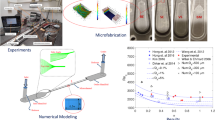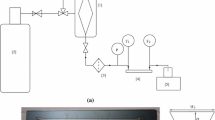Abstract
In this work the laminar-to-turbulent transition in microchannels of circular cross-section is studied experimentally. In order to single out the effects of relative roughness, compressibility and channel length-to-diameter ratio on the Reynolds number at which transition occurs, experimental runs have been carried out on circular microchannels in fused silica—smooth for all purposes—and in stainless steel (which possess a high surface roughness), with a diameter between 125 and 180 μm and a length of 5–50 cm through which nitrogen flows. For each tube the friction factor has been computed. The values of the critical Reynolds number have been determined plotting the Poiseuille number (i.e., the product of the friction factor, f, times the Reynols number, Re) as a function of the average Mach number between inlet and outlet. The transitional regime was found to start no earlier than at values of the Reynolds number around 1,800–2,000. It has been observed that surface roughness has no effect on the hydraulic resistance in the laminar region for a relative roughness lower than 4.4%, and that friction factor obeys the Poiseuille law, if it is correctly computed taking compressibility into account. It is found that recent correlations for the prediction of the critical Reynolds number in microchannels that link the relative roughness of the microtubes to the critical Reynolds number do not agree with the present results.






Similar content being viewed by others
Abbreviations
- A :
-
Cross-sectional area (m2)
- C :
-
Local loss coefficient
- D :
-
Inner diameter (m)
- F :
-
Friction factor
- L :
-
Microchannel length (m)
- \( \dot{m} \) :
-
Mass flow rate (kg s−1)
- Ma :
-
Mach number
- P :
-
pressure (Pa)
- R :
-
gas constant (J kg−1 K−1)
- Re :
-
Reynolds number
- T :
-
temperature (K)
- Δ:
-
difference
- δ :
-
relative uncertainty (%)
- ε :
-
roughness (m)
- γ :
-
specific heat ratio (cp/cv)
- μ :
-
dynamic viscosity (kg m−1 s−1)
- ρ :
-
density (kg m−3)
- avg:
-
average
- cf:
-
constricted flow
- cr:
-
critical
- Ex:
-
exit
- h:
-
hydraulic
- in:
-
inlet
- m:
-
measured
- n:
-
net
- no:
-
nominal
References
Acosta RE, Muller RH, Tobias WC (1985) Transport processes in narrow (Capillary) channels. AIChE J 31:473–482
Choi SB, Barron RF, Warrington RO (1991) Fluid flow and heat transfer in microtubes, micromechanical sensors, actuators and systems, ASME DSC 32. Atlanta, pp 123–134
ESDU 74029 (2003) Friction losses for fully-developed flow in straight pipes of constant cross-section—subsonic compressible flow
Gamrat G, Favre-Marinet M, Le Person S, Baviere R, Ayela F (2008) An experimental study and modelling of roughness effects on laminar flow in microchannels. J Fluid Mech 594:399–423
Hagen G (1854) Über den Einfluss der Temperatur auf die Bewegung des Wassers in Röhren. Abh. Kön. Akad. Wiss. 17–98
Hrnjak P, Tu X (2007) Single phase pressure drop in microchannels. Int J Heat Fluid Flow 28:2–14
Jones OC (1976) An improvement in the calculation of turbulent friction factor in rectangular ducts. Trans ASME J Fluids Eng 98:173–181
Kandlikar SG (2006) Single-phase liquid flow in minichannels and microchannels. In: Kandlikar SG, Garimella S, Li D, Colin S, King MR (eds) Heat transfer and fluid flow in minichannels and microchannels. Elsevier, Amsterdam
Kandlikar SG, Schmitt D, Carrano AL, Taylor JB (2005) Characterization of surface roughness effects on pressure drop in single-phase flow in minichannels. Phys Fluids 17:100606
Kohl MJ, Abdel-Khalik SI, Jeter SM, Sadowski DL (2005) An experimental investigation of microchannel flow with internal pressure measurements. Int J Heat Mass Transfer 48:1518–1533
Li ZX, Xia ZZ, Du DX (1999) Analytical and experimental investigation on gas flow in a microtube, In: Proceedings of Kyoto University–Tsinghua University Joint Conference on Energy and Environment, Kyoto, pp 239–244
Li ZX, Du DX, Guo ZY (2000) Characteristics of frictional resistance for gas flow in microtubes. Proc Symp Energy Eng 21st Century 2:658–664
Li ZX, Du DX, Guo ZY (2003) Experimental study on flow characteristics of liquid in circular microtubes. Microscale Thermophys Eng 7:253–265
Lorenzini M, Morini GL, Henning T, Brandner JJ (2008) Sensitivity analysis of the uncertainties in determining the friction factor in microchannels. Int J Therm Sci (in press)
Morini GL, Lorenzini M, Salvigni S (2006) Friction characteristics of compressible gas flows in microtubes. Exp Fluid Therm Sci 30:733–744
Morini GL, Lorenzini M, Colin S, Geoffroy S (2007) Experimental analysis of pressure drop and laminar to turbulent transition for gas flows in microtubes. Heat Transf Eng 28:670–679
Obot NT (1988) Determination of incompressible flow friction in smooth circular and noncircular passages. A generalized approach including validation of the century old hydraulic diameter concept. Trans ASME J Fluids Eng 110:431–440
Prandtl L, Tietjens OG (1957) Applied hydro- and aeromechanics. Dover, New York
Reynolds O (1883) An experimental investigation of the circumstances which determine whether the motion of water will be direct or sinuous and the law of resistence in parallel channels. Phil Trans R Soc 174:935–982
Shapiro A (1953) The dynamics and thermodynamics of compressible fluid flow. The Ronald Press Company, New York
Stanley RS, Barron RF, Ameel T (1997) Two-phase flow in microchannels. Proc of Micro Electro Mech Syst (MEMS) DSC/ASME 62:143–152
Tang GH, He YL (2004) An experimental investigation of gaseous flow characteristics in microchannels. In: Proceedings of second ASME international conference on microchannels and minichannels ICMM06, Rochester, pp 359–366
Tang GH, Li Z, He YL, Tao WQ (2007) Experimental study of compressibility, roughness and rarefaction influences on microchannel flow. Int J Heat Mass Transfer 50:2282–2295
Taylor JB, Carrano AL, Kandlikar SG (2006) Characterization of the effect of surface roughness and texture on fluid flow–past, present and future. Int J Therm Sci 55:962–968
Turner SE, Lam LC, Faghri M, Gregory OJ (2004) Experimental investigation of gas flow in microchannels. ASME J Heat Transf 126:753–763
Wu P, Little WA (1983) Measurement of friction factors for the flow of gases in very fine channels used for microminiature Joule–Thompson refrigerators. Cryogenics 23:273–277
Yang CY, Chien HT, Lu SR, Shyu RJ (2000) Friction characteristics of water, R–134a and air in small tubes. In: Proceedings of international conference on heat transfer and transport phenomena in microscale. Banff, Canada, pp 168–174
Yu D, Warrington RO, Barron R, Ameel T (1995) An experimental and theoretical investigation of fluid flow and heat transfer in microtubes. In: Proceedings of ASME/JSME thermal engineering joint conference, Maui, pp 523–530
Acknowledgments
This work has been funded by the Italian Ministry of Research in the framework of the PRIN 2007 action on Microfluidics.
Author information
Authors and Affiliations
Corresponding author
Rights and permissions
About this article
Cite this article
Morini, G.L., Lorenzini, M., Salvigni, S. et al. Analysis of laminar-to-turbulent transition for isothermal gas flows in microchannels. Microfluid Nanofluid 7, 181–190 (2009). https://doi.org/10.1007/s10404-008-0369-2
Received:
Accepted:
Published:
Issue Date:
DOI: https://doi.org/10.1007/s10404-008-0369-2




